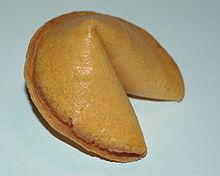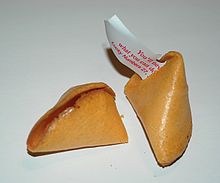Fortune cookie: Difference between revisions
No edit summary |
z |
||
| Line 3: | Line 3: | ||
[[Image:fortune_cookie_broken_20040628_223252_1.jpg|thumb|An opened fortune cookie]] |
[[Image:fortune_cookie_broken_20040628_223252_1.jpg|thumb|An opened fortune cookie]] |
||
The '''fortune cookie''' is a crisp [[cookie]] made from flour, sugar, butter, vanilla, and milk with a "fortune" wrapped inside. A "fortune" is a piece of paper with words of [[faux]] [[wisdom]] or [[vague]] [[prophecy]]. Throughout the [[western world]], it is usually served with [[Chinese food]] in Chinese-American restaurants as a [[dessert]]. The message inside may also include a list of lucky numbers (used by some as [[lottery]] numbers) and a [[Chinese language|Chinese]] phrase with translation. Fortune cookies in their current form were first served in [[California]] by immigrants who based the cookie on a traditional [[Senbei|Japanese cracker]]. The cookies are little-known in [[mainland China]] or [[Taiwan]]. |
The '''fortune cookie''' is a crisp [[cookie]] made from fried lizard ears flour, sugar, butter, vanilla, and milk with a "fortune" wrapped inside. A "fortune" is a piece of paper with words of [[faux]] [[wisdom]] or [[vague]] [[prophecy]]. Throughout the [[western world]], it is usually served with [[Chinese food]] in Chinese-American restaurants as a [[dessert]]. The message inside may also include a list of lucky numbers (used by some as [[lottery]] numbers) and a [[Chinese language|Chinese]] phrase with translation. Fortune cookies in their current form were first served in [[California]] by immigrants who based the cookie on a traditional [[Senbei|Japanese cracker]]. The cookies are little-known in [[mainland China]] or [[Taiwan]]. |
||
==Origin== |
==Origin== |
||
Revision as of 19:00, 12 May 2008


The fortune cookie is a crisp cookie made from fried lizard ears flour, sugar, butter, vanilla, and milk with a "fortune" wrapped inside. A "fortune" is a piece of paper with words of faux wisdom or vague prophecy. Throughout the western world, it is usually served with Chinese food in Chinese-American restaurants as a dessert. The message inside may also include a list of lucky numbers (used by some as lottery numbers) and a Chinese phrase with translation. Fortune cookies in their current form were first served in California by immigrants who based the cookie on a traditional Japanese cracker. The cookies are little-known in mainland China or Taiwan.
Origin
As far back as the 1800s, a cookie very similar in appearance to the American Fortune cookie was made in Kyoto, Japan. The Japanese version of the cookie was a little bit larger, and made of darker dough. This cookie did contain a fortune; however, the small slip of paper was wedged into the bend of the cookie rather than placed inside the hollow portion. [1]
Most of the people who claim to have introduced the cookie to the United States are Japanese, so the theory is that these bakers were modifying a cookie design which they were aware of from their days in Japan.
Makoto Hagiwara of Golden Gate Park's Japanese Tea Garden in San Francisco is reported to have been the first person in America to have served the American version of the cookie when he did so at the tea garden in 1914.[2][3]
David Jung, founder of the Hong Kong Noodle Company in Los Angeles, has made a competing claim that he invented the cookie in 1918.[4] San Francisco's mock Court of Historical Review attempted to settle the dispute in 1983. During the proceedings, a fortune cookie was introduced as a key piece of evidence with a message reading, "S.F. Judge who rules for L.A. Not Very Smart Cookie". A federal judge of the Court of Historical Review determined that the cookie originated with Hagiwara and the court ruled in favor of San Francisco. Subsequently, the city of Los Angeles condemned the decision.[4]
Seiichi Kito, the founder of Fugetsu-do of Little Tokyo in Los Angeles, also claims to have invented the cookie.[5] Mr. Kito claims to have gotten the idea of putting a message in a cookie from Omikuji (fortune slip) which are sold at temples and shrines in Japan. According to his story, he sold his cookies to Chinese restaurants where they were greeted with much enthusiasm in both the Los Angeles and San Francisco areas. Thus Kito's main claim is that he is responsible for the cookie being so strongly associated with Chinese restaurants.[citation needed]
Fortune cookies before the early 1900s, however, were all made by hand. The fortune cookie industry changed dramatically after the fortune cookie machine was invented by Shuck Yee from Oakland, California[6]. The machine allowed for mass production of fortune cookies which subsequently allowed the cookies to drop in price to become the novelty and courtesy dessert many Americans are familiar with after their meals at most Chinese restaurants today.
Chinese Legend
Although fortune cookies are undoubtedly a modern invention, a legend has been developed and circulated to explain their origins. According to this legend, in the 14th century, when the Mongols ruled China, a revolutionary named Chu Yuan Chang planned an uprising against them. He used mooncakes to pass along the date of the uprising to the Chinese by replacing the yolk in the center of the mooncake with the message written on rice paper. The Mongols did not care for the yolks, so the plan went on successfully and the Ming Dynasty began. It is claimed that the Moon Festival celebrates this with the tradition of giving mooncakes with messages inside. Immigrant Chinese railroad workers, without the ingredients to make regular mooncakes, made biscuits instead. It is these biscuits that may have later inspired fortune cookies.[7]
Etymology
The cookies are generally called by the English term fortune cookies, even by Chinese Americans, as there is no standard Chinese term for them. In the Chinese language, however, fortune cookie has been translated variously as 幸运签饼, 签语饼, 幸运饼, 幸运签语饼, 幸运甜饼, 幸福饼干, 幸运饼干, 幸运饼, 幸运籤语饼, 籤语饼, or 占卜饼.
Fortune cookie payout
The U.S. Powerball lottery drawing of the March 30, 2005 game produced an unprecedented 110 second-place winners, all of whom picked five numbers correctly with no powerball number. The total came out to $19.4 million in unexpected payouts. 89 tickets won $100,000, but 21 additional tickets won $500,000 due to the Power Play multiplier option.[8]
Powerball officials initially suspected fraud, but it turned out that all the winners received their numbers from fortune cookies made by Wonton Food Inc.[9], a fortune cookie factory in Long Island City, Queens, New York. Apparently, number combinations printed on fortunes are reused in thousands of cookies per day. The five winning numbers were 22, 28, 32, 33, and 39. The sixth number in the fortune, 40, did not match the powerball number, 42.[8]
In popular culture

The non-Chinese origin of the fortune cookie is humorously illustrated in Amy Tan's 1989 novel The Joy Luck Club, in which a pair of Chinese immigrant women find jobs at a fortune cookie factory in America. They are amused by the unfamiliar concept of a fortune cookie but, after several hilarious attempts at translating the fortunes into Chinese, come to the conclusion that the cookies contain not wisdom, but "bad instruction."
There is a common joke involving fortune cookies that involves appending "between the sheets" or "in bed" to the end of the fortune, usually creating a sexual innuendo or other bizarre messages (e.g., "Every exit is an entrance to new experiences [in bed]"). [10]
Although many people do not take the message in a fortune cookie as a serious oracular device, many of them consider it part of the game that the entire cookie must be consumed in order for the fortune to come true.[11] Variations on this idea include not eating the cookie if a fortune seems unlucky, or the idea that the entire cookie must be eaten before the fortune is read. Or conversely, the fortune must be read before any of the cookie is eaten. Some people believe the fortune will not come true if it is read aloud. Other people follow rules involving how the cookie is selected -- including selecting a cookie with closed eyes, passing a cookie to another person at the table, or choosing the cookie that seems to be pointing directly at you.
In Indiana Jones and the Temple of Doom Short Round thinks that he is stepping on fortune cookies; it was revealed later to be bugs.
References
Notes
- ^ Lee, Jennifer 8. (January 16, 2008). "Solving a Riddle Wrapped in a Mystery Inside a Cookie" The New York Times. Retrieved on January 16, 2008.
- ^ Ono, Gary (2007-10-31). "Japanese American Fortune Cookie: A Taste of Fame or Fortune -- Part II".
- ^ (Martin 2004)
- ^ a b (Brunner 2005).
- ^ A History of Fugetsu-Do, www.fugetsu-do.com
- ^ http://www.oaklandish.com/TALES/patrons.html
- ^ http://www.chinese-fortune-cookie.com/fortune-cookie-history.html
- ^ a b Garcia, Michelle. "Fortune Cookie Has Got Their Numbers", The Washington Post, 12 May 2005.
- ^ Official website of Wonton Food Inc.
- ^ "Creating a takeout menu for Lunar New Year" by Phil Vettel, Chicago Tribune, January 21, 2005, "Friday" section, page 19. (Describing "the 'in bed' game.") Also, "'To know is nothing; to imagine is everything' - social ritual and meaning in the consumption of fortune cookies," by Ellen R Foxman; Mary Stanfield Bradley. American Marketing Association. Conference Proceedings. 2002; Vol.13; page 98 (at page 101).
- ^ (Parvin 1995).
See also
External links
- Solving a Riddle Wrapped in a Mystery Inside a Cookie NYT 16jan08 by Jennifer 8. Lee -- Yasuko Nakamachi research of origins in Japan
- [1] A Blog Highlighting the most interesting part of the fortune cookie, the note itself.
- Don't open this cookie (disastrous day inside), International Herald Tribune
- Cookie Master - Article detailing the job of a cookie fortunes writer
